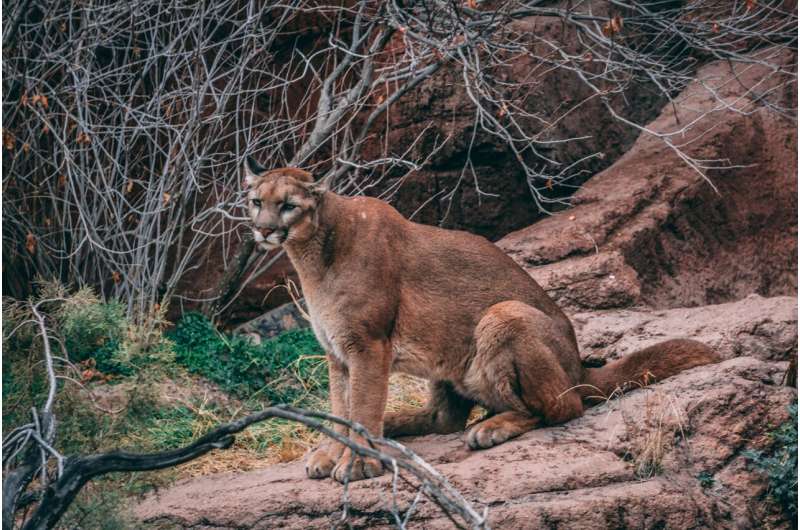This article has been reviewed according to Science X's editorial process and policies. Editors have highlighted the following attributes while ensuring the content's credibility:
fact-checked
reputable news agency
proofread
California mountain lion population is thousands fewer than previously estimated

Scientists have completed the first comprehensive estimate of mountain lions in California, a vital statistic needed to shape puma-friendly land-use decisions and ensure that the predators can find room to roam, mate and find prey.
The total number of mountain lions is estimated to be between 3,200 and 4,500, which is thousands fewer than previously thought. The count was conducted by state and university scientists who used GPS collar data and genetic information from scat samples to model population densities across the Sierra Nevada Mountains, the Mojave Desert and Southern California's patchwork of weedy, fire-stripped wilderness.
"The greatest density is in the coastal forests of Humboldt and Mendocino counties of Northwest California, and lowest is the high desert east of the Sierra Nevada range in Inyo County," said Justin Dellinger, a large-carnivore biologist and leader of the California Mountain Lion Project effort. "The Central Valley and portions of the Mojave Desert have no mountain lions."
A report on the project's findings will be reviewed by experts prior to publication in a scientific journal later this year.
"There's never been a study of this scale and over such a large and diverse geographical area with such a variety of habitats," said Winston Vickers, a co-author of the study and a veterinarian at the UC Davis Wildlife Health Center.
The California Department of Fish and Wildlife had for decades estimated that the state's mountain lion population was roughly 6,000—even despite relentless vehicle strikes, wildfires and encroachment by land-hungry humans throughout their range.
"That old figure was just a back-of-the-envelope calculation without much data to support it," Dellinger said. "The new, more accurate information we collected will be used to conserve and manage mountain lions more appropriately."
In a collaborative effort involving the California Department of Fish and Wildlife, UC Davis, UC Santa Cruz, the nonprofit Institute for Wildlife Studies and the nonprofit Audubon Canyon Ranch, Dellinger and others traipsed through mountain forests, canyons and desert badlands in search of tracks. They also set trail cameras and traps, tranquilized lions, took biological samples and fitted animals with tracking collars.
Dellinger said the group spent roughly $2.45 million in state funds over seven years to produce three population estimates: One suggests there are 4,511 cougars living in California, and the other two suggest the number is roughly 3,200.
Deciding which figure is most precise will be challenging for biologists tasked with reviewing the census report.
They already agree on one thing: Humans are the greatest threat to mountain lions. In California, close to 40 million people live within, or adjacent to, cougar habitat.
Mountain lions as a species are not listed as endangered. But in Southern California, vehicle strikes, rat poison, inbreeding, wildfires, poaching, urban encroachment and freeway systems are all contributing to what scientists call an "extinction vortex."
There's an almost 1 in 4 chance that the charismatic cats could be extinct in the Santa Monica and Santa Ana Mountains within 50 years.
The state Fish and Game Commission has granted cougars in six regions—from Santa Cruz to the U.S.-Mexico border—extra protection under "candidate status" to be listed as threatened.
The action came in response to a petition co-sponsored by the Center for Biological Diversity and the nonprofit Mountain Lion Foundation. It argues that six isolated and genetically distinct cougar clans within those areas comprise a sub-population that is threatened with extinction.
The commission is expected to make a final decision later this year.
"We look forward to getting mountain lions the protection that is clearly warranted and desperately needed," said Brendan Cummings, the Center for Biological Diversity's conservation director.
The effect of the designation would be far-reaching.
If the state Fish and Game Commission agrees, the state Department of Transportation would not be allowed to build or expand highways in core mountain lion habitat without implementing adequate measures to ensure linkages and safe passage over them.
In addition, large-scale residential and commercial development could be prohibited or limited in mountain lion habitats within a region covering roughly a third of the state.
The new mountain lion population assessment comes at a time of ongoing efforts by the state Department of Fish and Wildlife to identify and prioritize wildlife movement barriers across the state. It also comes at a time of growing support for wildlife crossings.
One such bridge is the $87-million Wallis Annenberg Wildlife Crossing, currently being constructed over a 10-lane stretch of the 101 Freeway near Liberty Canyon in Agoura Hills.
In the meantime, officials are preparing new census campaigns to help guide development choices in areas where conflicts with other big predators over territory are testing public fortitude.
"The state is trying to get a black bear census off the ground," Dellinger said. "Having as much data as possible is always best for managing species like that, especially in places where wilderness is overcrowded with people."
2024 Los Angeles Times.
Distributed by Tribune Content Agency, LLC.

















